
The last notes of the azaan died out, and in homes all over the para, the faithful had already broken their fast, and many were hurrying through their prayers. Despite having refrained from eating and drinking the entire day, food seems to be the last thing on anyone's mind.
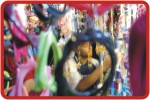 Slowly, in twos and threes, they make their way to the rooftops. The young ones chatter excitedly jumping up and down, but the adults merely exchange nods and smiles as they raise their heads skywards. A hush descends upon the neighbourhood, and all activity comes to a standstill as everyone waits with bated breath. Then suddenly someone spots it, the barest silver sliver of a crescent resting against the vivid backdrop of pinks, mauves
Slowly, in twos and threes, they make their way to the rooftops. The young ones chatter excitedly jumping up and down, but the adults merely exchange nods and smiles as they raise their heads skywards. A hush descends upon the neighbourhood, and all activity comes to a standstill as everyone waits with bated breath. Then suddenly someone spots it, the barest silver sliver of a crescent resting against the vivid backdrop of pinks, mauves  and purples that is the sky. A shout goes up, and reverberates through the entire neighbourhood as heads are turned, and fingers are pointed upwards. The cheers rise to a deafening volume, and somewhere, someone has even managed to pop a few firecrackers. Shouts of 'Eid Mubarak' go up everywhere, as everyone celebrates the end of another rigorous month of fasting, abstinence, and piety, for tonight is the eve of Eid-ul-Fitr, popularly known as 'chand raat'.
and purples that is the sky. A shout goes up, and reverberates through the entire neighbourhood as heads are turned, and fingers are pointed upwards. The cheers rise to a deafening volume, and somewhere, someone has even managed to pop a few firecrackers. Shouts of 'Eid Mubarak' go up everywhere, as everyone celebrates the end of another rigorous month of fasting, abstinence, and piety, for tonight is the eve of Eid-ul-Fitr, popularly known as 'chand raat'.
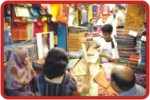 Even a decade ago, this would be a typical end-of-Ramadan scene. In many ways, chand raat, and for many, still is, even more exciting than Eid itself. Shahid, a senior professional reminisces about the eves of Eid during his childhood, way back in the 50's. “The entire para would be bustling with activity. The preparations would commence from after iftar and continue till dawn. Sleep was simply out of the question! The para tailor would come around, making last-minute reparations, and if you had changed your mind about what you wanted to wear on Eid, this was the time to do it. It wasn't unusual, especially for the
Even a decade ago, this would be a typical end-of-Ramadan scene. In many ways, chand raat, and for many, still is, even more exciting than Eid itself. Shahid, a senior professional reminisces about the eves of Eid during his childhood, way back in the 50's. “The entire para would be bustling with activity. The preparations would commence from after iftar and continue till dawn. Sleep was simply out of the question! The para tailor would come around, making last-minute reparations, and if you had changed your mind about what you wanted to wear on Eid, this was the time to do it. It wasn't unusual, especially for the 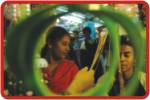 young ones, to decide they were dissatisfied with their outfits or accessories, so a mad dash to the stores to exchange was a common phenomenon. I personally remember throwing a tantrum once, as a little child, because my punjabi didn't have the churidar sleeves that were the fashion at that time, so fresh material had to be bought to make new sleeves,” he recollects with a quiet chuckle.
young ones, to decide they were dissatisfied with their outfits or accessories, so a mad dash to the stores to exchange was a common phenomenon. I personally remember throwing a tantrum once, as a little child, because my punjabi didn't have the churidar sleeves that were the fashion at that time, so fresh material had to be bought to make new sleeves,” he recollects with a quiet chuckle.
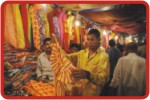 Back in those days, extended families were the norm, not the exception, so the process of getting ready for the big celebrations was an event in itself. “The older women in the family would be busy in the kitchen, preparing the next day's meal, while younger girls would be busy preparing and putting on mehendi” says Rita, a housewife. “The children would be underfoot, cousins and siblings running around and laughing
Back in those days, extended families were the norm, not the exception, so the process of getting ready for the big celebrations was an event in itself. “The older women in the family would be busy in the kitchen, preparing the next day's meal, while younger girls would be busy preparing and putting on mehendi” says Rita, a housewife. “The children would be underfoot, cousins and siblings running around and laughing  out of sheer excitement, while the men would at best be out buying the groceries and supplies, or simply be the useless beings they still are,” she adds with a mischievous giggle.
out of sheer excitement, while the men would at best be out buying the groceries and supplies, or simply be the useless beings they still are,” she adds with a mischievous giggle.
For Shayla, a working mom, chand raat holds a wealth of special memories for her. “The eve of Eid was always reserved for shopping sprees to buy trinkets to  go with my new clothes. My father would take me out to New Market and I'd pick out lockets and earrings, and other costume jewellery. I particularly remember this one season where I got beaded lockets shaped like fruits; apples, grapes, oranges…they were so cute! I still make a point of making a round at New Market to see what's on display. It's a personal tradition of mine.”
go with my new clothes. My father would take me out to New Market and I'd pick out lockets and earrings, and other costume jewellery. I particularly remember this one season where I got beaded lockets shaped like fruits; apples, grapes, oranges…they were so cute! I still make a point of making a round at New Market to see what's on display. It's a personal tradition of mine.”
 The chand raat scenario, needless to say, has changed drastically over the years. The 'experts' (who never seem to be able to agree amongst themselves) take care of the moon watching, and the rest of us get to hear about it on the TV news bulletin. So much for the feeling of togetherness where the whole neighbourhood congregates on the rooftops to spot the moon. The break up of the traditional family into smaller nuclear families means that there are fewer grand kitchen scenes, and the availability of readymade food has eliminated to a large extent the need for heavy-duty cooking anyway. The proliferation of boutiques and fashion houses offering ready-made clothing has also pretty much made the 'para' tailor obsolete.
The chand raat scenario, needless to say, has changed drastically over the years. The 'experts' (who never seem to be able to agree amongst themselves) take care of the moon watching, and the rest of us get to hear about it on the TV news bulletin. So much for the feeling of togetherness where the whole neighbourhood congregates on the rooftops to spot the moon. The break up of the traditional family into smaller nuclear families means that there are fewer grand kitchen scenes, and the availability of readymade food has eliminated to a large extent the need for heavy-duty cooking anyway. The proliferation of boutiques and fashion houses offering ready-made clothing has also pretty much made the 'para' tailor obsolete.
 Even so, the chand raat still does see a lot of activity. For one thing, the tradition of chand raat shopping is still a popular one, especially because, in a bid to clear out the unsold stocks, the shop-owners generously slash their prices, so the eagle-eyed buyers can come back home with incredible bargains. “I always make a point to do some shopping on chand raat,” states Numaira, a young executive. “My worst chand raat experience was that one year where news of the moon sighting came at 10 p.m. What a rush that created!”
Even so, the chand raat still does see a lot of activity. For one thing, the tradition of chand raat shopping is still a popular one, especially because, in a bid to clear out the unsold stocks, the shop-owners generously slash their prices, so the eagle-eyed buyers can come back home with incredible bargains. “I always make a point to do some shopping on chand raat,” states Numaira, a young executive. “My worst chand raat experience was that one year where news of the moon sighting came at 10 p.m. What a rush that created!”
Another place that sees a lot of activity on this night is the beauty parlour. The fashionistas of the city flock to their respective salons to get some last minute primping done, particularly the mehendi work. In fact the mehendi ritual is probably the one that's remained most popular after all these years. “No matter what else we do on Eid, my cousins and I never miss out on making mehendi designs on our hands on the night before,” says Tonima.
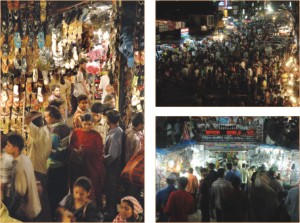 As it happens with all social events, the rituals of the chand raat have changed over the years. Be it due to commercialisation, urbanisation, or simply the wheel of time, the changes were inevitable, and are probably irreversible. What remains the same, however, is the fact that as long as people continue to observe Ramadan and celebrate Eid, the eve before the event will always enjoy a special kind of charm, and here's wishing our readers the joy of the chand raat. As the old song goes…Romjaner ei rojar sheshe elo khushir Eid… Eid Mubarak!
As it happens with all social events, the rituals of the chand raat have changed over the years. Be it due to commercialisation, urbanisation, or simply the wheel of time, the changes were inevitable, and are probably irreversible. What remains the same, however, is the fact that as long as people continue to observe Ramadan and celebrate Eid, the eve before the event will always enjoy a special kind of charm, and here's wishing our readers the joy of the chand raat. As the old song goes…Romjaner ei rojar sheshe elo khushir Eid… Eid Mubarak!
By Sabrina F Ahmad
Photo: Munem Wasif

